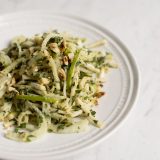Cylindrical, knobby and coarse, fresh horseradish root is not pretty. But its bite is better than its bark, providing a spicy kick that far outstrips the jarred stuff.
And the best bet for unlocking the pungent power of the root is grating. The rough treatment damages the root’s cells, releasing an enzyme that converts natural compounds into its characteristic heat.
But those compounds break down with time. Adding salt and vinegar—as in prepared horseradish—slows the process, but only for a bit. Which is why, for those who like the mustardy heat of horseradish, fresh is best.
Look for fresh horseradish in the refrigerated produce section, near other root vegetables such as turnips, parsnips and carrots. Peel it and finely grate it with a wand-style grater for fine shreds. Make sure you grate in an open and well-ventilated space since the compounds are quite volatile.
For a light, fresh dish that would stand up to (and complement) horseradish’s heat, we made a salad of tart apples, celery root and fennel. A mandoline made quick work of all three ingredients. Chopped parsley and mint were bright and cooling additions. And a handful of toasted chopped hazelnuts was a perfect final scattering of crunch.
Home cooks have used a mandoline, a paddle-like slicing blade over which food is slid back and forth, effectively shaving off thin slices with each pass.
Unfortunately, most cooks also have a horror story—sliced fingertips, shaved knuckles, even hospital visits—to go with the experience.
The ease of the food processor’s slicing disc is a tempting alternative to the risk of injury. But a processor—never mind a knife—can’t cut near-sheer slivers like a mandoline can.
To size up the difference, we sliced a carrot three ways: with a mandoline, the slicing disc of a food processor and a sharp knife. It wasn’t even close. The mandoline reduced the carrot to slices roughly the thickness of 5 sheets of copy paper; the knife came in at 15; the disc more than 20.
But thin doesn’t win if you lose fingertips in the process. For safety, we like to wear a cut-resistant glove on our slicing hand. Though made with tough materials such as Kevlar, a glove isn’t completely safe. But it does add a layer of protection between your fingers and a blade.
We preferred the snug fit of Microplane’s tightly knit glove, which sells for about $15. Whatever the brand, make sure the fit is tight; excess material can snag.
Likewise, make use of the hand guard that comes with the mandoline. While it’s not very helpful in the first dozen slices or so—when you can safely hold food by hand—as the vegetable gets smaller, it is a good buffer between the blade and your fingertips. We prefer small, simple hand guards with tiny spikes. More complicated guards with adjustable prongs were less effective.
We also generally favored simple, inexpensive mandolines. The lightweight Kyocera (about $15), which uses a ceramic blade, is easy to hold, includes a simple guard and is adjustable.




